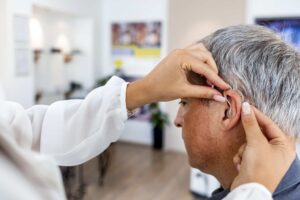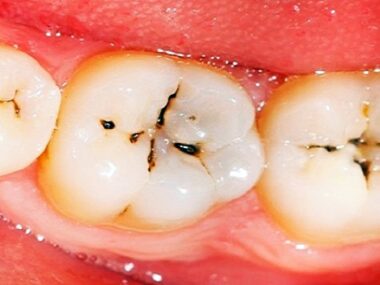Hearing loss is a prevalent sensory impairment that can significantly impact an individual’s quality of life. It can occur at any stage of life and stem from a variety of causes, ranging from genetic predispositions to environmental factors.
In this comprehensive guide, we delve into the diverse etiologies of hearing loss, categorizing them into congenital and acquired forms and further exploring the distinctions between conductive, sensorineural, and mixed hearing loss.
Congenital Hearing Loss
Congenital hearing loss refers to hearing impairment present at birth or acquired shortly thereafter. It can result from a combination of genetic and non-genetic factors, affecting the development or function of the auditory system.
Genetic Factors: Genetic mutations inherited from one or both parents can predispose individuals to congenital hearing loss. These mutations may affect genes responsible for cochlear development, hair cell function, or signal transduction within the auditory pathway. Non-Genetic Factors: Non-genetic causes of congenital hearing loss include prenatal infections (such as cytomegalovirus or rubella), maternal exposure to ototoxic medications or substances, complications during pregnancy or childbirth, prematurity, low birth weight, and congenital anomalies of the ear structures.
Acquired Hearing Loss

Acquired hearing loss develops later in life and can result from various environmental, medical, and lifestyle factors.
Aging (Presbycusis): Age-related hearing loss, known as presbycusis, is a common form of acquired hearing impairment attributed to degenerative changes in the auditory system over time. Degeneration of hair cells in the cochlea and diminished function of the auditory nerve contribute to the progressive decline in hearing sensitivity, particularly for high-frequency sounds.
Noise Exposure: Prolonged or excessive exposure to loud noises, such as industrial machinery, firearms, recreational activities (e.g., concerts, sporting events), and personal listening devices (e.g., headphones, earbuds), can cause noise-induced hearing loss. Exposure to loud noises damages the delicate hair cells in the cochlea, leading to irreversible hearing loss, often characterized by difficulty understanding speech in noisy environments and ringing in the ears (tinnitus).
Infections: Certain infections, such as otitis media (middle ear infection), meningitis, mumps, measles, and cytomegalovirus (CMV), can cause acquired hearing loss by damaging the auditory structures or triggering inflammatory responses within the ear.
Ototoxic Medications: Some medications have the potential to cause hearing loss or exacerbate existing auditory problems by damaging the hair cells or auditory nerve. Common ototoxic medications include certain antibiotics (e.g., aminoglycosides), chemotherapy drugs, loop diuretics, and nonsteroidal anti-inflammatory drugs (NSAIDs).
Traumatic Injury: Head trauma, concussions, and injuries to the ear or temporal bone can result in acquired hearing loss, either by direct damage to the auditory structures or secondary to neurological complications. Traumatic noise exposure, such as explosions or blast injuries, can also cause sudden sensorineural hearing loss due to intense pressure changes and acoustic trauma.
Conductive, Sensorineural, and Mixed Hearing Loss: Hearing loss can be broadly classified into three main types based on the affected part of the auditory system: conductive, sensorineural, and mixed.
Conductive Hearing Loss: Conductive hearing loss occurs when sound waves are unable to travel efficiently through the outer or middle ear to the inner ear (cochlea). Common causes include ear infections, otosclerosis (abnormal bone growth in the middle ear), perforated eardrum, impacted earwax, and congenital abnormalities of the ear canal or ossicles (middle ear bones). Conductive hearing loss is often characterized by reduced sound intensity or muffled sound perception.
Sensorineural Hearing Loss: Sensorineural hearing loss results from damage or dysfunction of the inner ear (cochlea) or auditory nerve pathways leading to the brain. Causes include ageing (presbycusis), noise exposure, genetic factors, ototoxic medications, infections, and traumatic injuries. Sensorineural hearing loss typically affects both the perception of sound intensity and clarity, making it difficult to understand speech, especially in noisy environments. It may also be associated with tinnitus (ringing in the ears).
Mixed Hearing Loss: Mixed hearing loss refers to a combination of conductive and sensorineural components, involving impairment in both the middle ear and inner ear or auditory nerve. Mixed hearing loss can occur due to a variety of factors, such as chronic ear infections with underlying sensorineural damage, otosclerosis with associated cochlear involvement, or traumatic injuries affecting multiple auditory structures.
Conclusion:
Understanding the causes and types of hearing loss is essential for early detection, appropriate intervention, and effective management of auditory impairments. Whether congenital or acquired, conductive or sensorineural, each form of hearing loss presents unique challenges and considerations.
By recognizing the diverse etiologies and manifestations of hearing loss, healthcare professionals, educators, and individuals themselves can work together to promote auditory health, enhance communication, and improve the overall quality of life for those affected by hearing impairment.
Related Tags
Taiwo Olawuyi
Taiwo Olawuyi is a highly dedicated and passionate professional blogger, renowned for her ability to create captivating, informative, and engaging content in the realm of health and wellness. She holds a Bachelor's degree in Political Science from Olabisi Onabanjo University and a Master's degree in Adult Education from the prestigious University of Ibadan. Her profound passion for health and wellness, coupled with her unwavering dedication to her audience, serves as a constant source of inspiration and enlightenment for readers worldwide.










